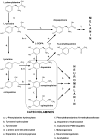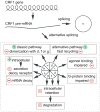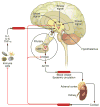Sensing the environment: regulation of local and global homeostasis by the skin's neuroendocrine system
- PMID: 22894052
- PMCID: PMC3422784
- DOI: 10.1007/978-3-642-19683-6_1
Sensing the environment: regulation of local and global homeostasis by the skin's neuroendocrine system
Abstract
Skin, the body's largest organ, is strategically located at the interface with the external environment where it detects, integrates, and responds to a diverse range of stressors including solar radiation. It has already been established that the skin is an important peripheral neuro-endocrine-immune organ that is tightly networked to central regulatory systems. These capabilities contribute to the maintenance of peripheral homeostasis. Specifically, epidermal and dermal cells produce and respond to classical stress neurotransmitters, neuropeptides, and hormones. Such production is stimulated by ultraviolet radiation (UVR), biological factors (infectious and noninfectious), and other physical and chemical agents. Examples of local biologically active products are cytokines, biogenic amines (catecholamines, histamine, serotonin, and N-acetyl-serotonin), melatonin, acetylocholine, neuropeptides including pituitary (proopiomelanocortin-derived ACTH, beta-endorphin or MSH peptides, thyroid-stimulating hormone) and hypothalamic (corticotropin-releasing factor and related urocortins, thyroid-releasing hormone) hormones as well as enkephalins and dynorphins, thyroid hormones, steroids (glucocorticoids, mineralocorticoids, sex hormones, 7-delta steroids), secosteroids, opioids, and endocannabinoids. The production of these molecules is hierarchical, organized along the algorithms of classical neuroendocrine axes such as hypothalamic-pituitary-adrenal axis (HPA), hypothalamic-thyroid axis (HPT), serotoninergic, melatoninergic, catecholaminergic, cholinergic, steroid/secosteroidogenic, opioid, and endocannbinoid systems. Dysregulation of these axes or of communication between them may lead to skin and/ or systemic diseases. These local neuroendocrine networks are also addressed at restricting maximally the effect of noxious environmental agents to preserve local and consequently global homeostasis. Moreover, the skin-derived factors/systems can also activate cutaneous nerve endings to alert the brain on changes in the epidermal or dermal environments, or alternatively to activate other coordinating centers by direct (spinal cord) neurotransmission without brain involvement. Furthermore, rapid and reciprocal communications between epidermal and dermal and adnexal compartments are also mediated by neurotransmission including antidromic modes of conduction. In conclusion, skin cells and skin as an organ coordinate and/or regulate not only peripheral but also global homeostasis.
Figures























References
-
- Abe M, Itoh MT, Miyata M, Ishikawa S, Sumi Y. Detection of melatonin, its precursors and related enzyme activities in rabbit lens. Exp Eye Res. 1999;68:255–262. - PubMed
-
- Aberg KM, Radek KA, Choi EH, Kim DK, Demerjian M, Hupe M, Kerbleski J, Gallo RL, Ganz T, Mauro T, Feingold KR, Elias PM. Psychological stress downregulates epidermal antimicrobial peptide expression and increases severity of cutaneous infections in mice. J Clin Invest. 2007;117:3339–3349. - PMC - PubMed
-
- Aguilera G, Rabadan-Diehl C, Nikodemova M. Regulation of pituitary corticotropin releasing hormone receptors. Peptides. 2001;22:769–774. - PubMed
-
- Akhmetshina A, Dees C, Busch N, Beer J, Sarter K, Zwerina J, Zimmer A, Distler O, Schett G, Distler JH. The cannabinoid receptor CB2 exerts antifibrotic effects in experimental dermal fibrosis. Arthritis Rheum. 2009;60:1129–1136. - PubMed
Publication types
MeSH terms
Substances
Grants and funding
LinkOut - more resources
Full Text Sources
Other Literature Sources

